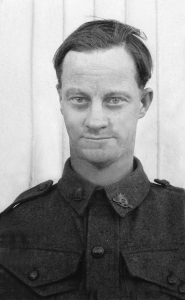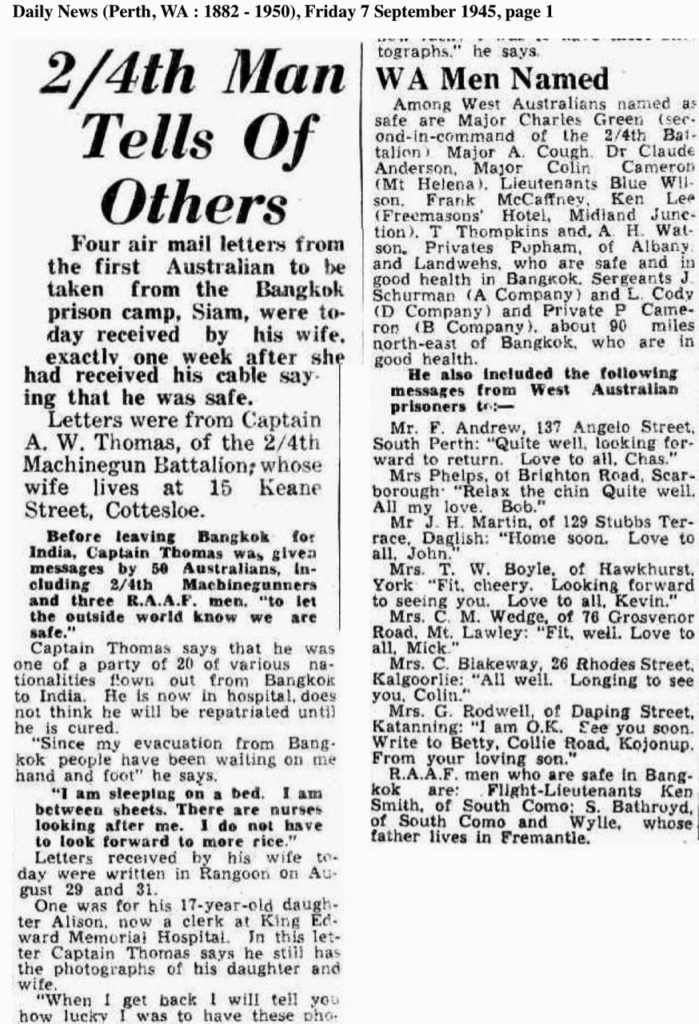Saigon - French Indo China
Saigon – French Indo China
Saigon was one of the largest shipping centres in South China Sea. The bulk of Japanese shipping for Thailand and French-Indo China came through this port. It was an essential port for Japan to send troops and equipment northwards to the Burma push via the Burma-Thai Railway.
Other than ‘Both’ Party which was sailed to Saigon, several other POWs were in French Indo China. Some were left behind ill when the party they were travelling to Japan departed Saigon. They had arrived and departed by rail. Others were sent there with various work parties.
These men included
WX6967 James Howe (Green Force No. 3 Btn selected ‘Rakuyo Maru Party’ Kumi No. 40) remained behind sick when his party departed Saigon to return to Singapore.
WX7438 Bryan Manwaring (Green Force No. 3 Btn selected ‘Rakuyo Maru’ Party whilst in Tamarkan) remained behind sick in Saigon.
WX10354 Harold Thomas Clayden (Java Party No 4 Williams Force) worked Burma and Thailand on Railway before being selected to go to Japan whilst at Tamarkan Camp. He was with ‘Awa Maru’ party which had gone to Saigon to sail to Japan, but returned to Singapore. Clayden remained behind sick.
WX8373 Leonard Greaves Green Force No. 3 Btn selected at Tamarkan, Thailand with ‘Awa Maru’ Party to travel to Saigon and Japan. Fell ill, and was left behind.
WX15869 Albert John Struthoff with ‘Green Force arrived Rakuyo’ Maru Party. He was ill and remained behind when his Party left for Singapore (Saigon Harbour too difficult to negotiate with American Submarine blockade) Died Phjeumonia Tan Son Nhut, French Indo China 19 Sept 1944, b. Chi Hoa Cemetery, Saigon.
By coincidence, Bert Struthoff died about same time his mates with Rakuyo Maru Party nearly all perished in South China Sea (12 Sep 1944)
Saigon prisoner of war camp was located on Jean Eudel Street (Duong Nguyen Tat Thanh, Ho Chi Min City) in the city of Saigon about 200 m from the river and about 600m from the canal. The camp was situated in the immediate vicinity of the Saigon port area on a farm which was infested with mosquitoes. The camp was surrounded by Japanese warehouses and store yards where ammunition, gasoline and kerosene was stored, a danger zone and a military target.
There were seven barracks, 150 feet long and 30 feet wide within the compound. Not all barracks were available for use at any one time – each POW was provided 2.5 feet space, The buildings were in fact ‘temporary’ – 4 were bamboo with atap roof and earth floor and 3 were wooden framed with tiled roof and concrete floor. No windows of course and each hut a 5 foot central walkway. Tiered shelves were installed for sleeping platforms. The luxury of this accommodation was electrical lighting at night – mostly dim. The whole compound was 150 yards by 150 yards. Two fences enclosed the compound. One of barbed wire and another of bamboo 20 feet high.
A hospital was installed in a warehouse.
The following detailed descriptions have been taken from American end of war report.









Bert Wall with ‘Rakuyo’ Maru Party spent about 6-8 weeks in Saigon before they were returned to Singapore to sail to Japan.
He said with his experience in Saigon there was little to no contact with the local French. Except they would ride their bicycles past a work party and ‘things’ would fall from the back of their bikes. ‘Things’ meaning pieces of food etc.
They were made to work on the Saigon docks, loading and unloading from boats. Of course the POWs would steal whenever they were able. Bert stole onions, which turned out to be very hot. He was made to eat them. He was also tied to barb wire fence because he was found with a stolen tin of beef. He assured us it was not so bad! (particularly in light of punishment meted out to him at Sakata Camp in Japan.
Please read further about Both Party and men of 2/4th
The port of Saigon had a river frontage of 5 kilometres from the mouth of the Canal de la Derivation to just beyond the Arrovo de l’Avalanche. The wharves handling commercial traffic were located in the southern region of the port, which was divided by the Arroyo Chinois. The naval dockyards and arsenal lay to the north of the town.
The wharves were constructed of steel and concrete with numerous go-downs adjacent to the wharves that ran at right angles to the river. The average go-down was in the region of 150 feet long by 50 feet wide and behind these warehouses a railway line ran to the main terminus in Saigon.



Map below shows the convenience of initially sending POWs to be shipped to Japan from Saigon until the effectiveness of the Allied Blockade. The railway line extended as far as Phnon Penh.
The French Colony included Laos and Cambodia.

The Japanese invasion of French Indo-China was an undeclared and very short military confrontation in northern Indo-China. This lasted just a few short days between 22 to 26 September 1940. With the fall of France in WW2, Japan pressurised the French Petain Government in French-Indo-China to work with them.
Japan wanted to prevent China from importing arms and fuel through French Indo-China via Kunming-Hai Phong Railway from the port of Haiphong through to Hanoi and onto to Kunmingin, Yunan, China.
The French government had introduced quite extensive rail services throughout French Indo-China commencing in the late 1890s.
Several 2/4th men died in French Indo-China:
WX15869 Albert John Struthoff had fallen ill on 23 June 1944 and died in a railway rest room at Tan Son Nhut as a result of pneumonia and dysentery at 2100 hours, 23 June 1944. His body was buried at Chi Hoa Cemetery, Saigon and his remains exhumed and reburied at Kanji War Cemetery after the war. (Albert went to Burma end of Railway with Green Force S Battalion, and was selected fit to go to Japan with ‘Rakuyo Maru’ Party. Albert was 30 years old.
Below: Stuthoff on right and photo of his grave in Saigon.




